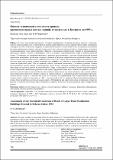| dc.contributor.author | Черноиван, Николай Вячеславович | |
| dc.coverage.spatial | Минск | ru_RU |
| dc.date.accessioned | 2025-05-23T08:09:58Z | |
| dc.date.available | 2025-05-23T08:09:58Z | |
| dc.date.issued | 2025 | |
| dc.identifier.citation | Черноиван, Н. В. Оценка технического состояния кровель крупнопанельных жилых зданий, возведенных в Беларуси до 1993 г. / Н. B. Черноиван. – Текст : непосредственный // Наука и техника. - 2025. - № 2. – С. 134–142 : ил. - Библиография: 12 назв. | ru_RU |
| dc.identifier.uri | https://rep.bstu.by/handle/data/48437 | |
| dc.description | Chernoivan N. V.Assessment of the Technical Condition of Roofs of Large-Panel Residential Buildings Erected in Belarus before 1993 | ru_RU |
| dc.description.abstract | В статье дана оценка технического состояния совмещенных утепленных рулонных кровель с последовательным расположением слоев и вентилируемых кровель крупнопанельных жилых зданий типовых серий, построенных в Беларуси до 1993 г. Результаты натурных исследований показали, что после более 30 лет эксплуатации техническое состояние материалов основных конструктивных слоев (несущая конструкция покрытия, пароизоляция, материалы теплоизоляционного слоя) работоспособное. Дефекты, оказывающие отрицательное влияние на функциональную пригодность кровель в целом, зафиксированы только в основном водоизоляционном ковре и цементно-песчаной стяжке. Установлено, что причинами появления и развития эксплуатационных дефектов (потеря защитной посыпки кровельным материалом, застой воды на кровле, трещины в битумном окрасочном слое рулонной кровли, вздутия между слоями кровельного рулонного ковра) являются «жесткие» условия эксплуатации кровель: постоянное, в течение всего срока эксплуатации, влияние на материалы атмосферных воздействий, а также нарушения технологии производства кровельных работ. Для поддержания рабочего состояния совмещенных утепленных рулонных кровель крупнопанельных жилых зданий, эксплуатируемых более 30 лет, основные материальные и финансовые затраты приходятся на частичный ремонт водоизоляционного ковра, включающий и локальный ремонт цементно-песчаной стяжки. Причиной локального разрушения стяжки кровель крупнопанельных жилых зданий, построенных до 1993 г., является недостаточная ее морозостойкость, обусловленная заложенным при проектировании таких зданий требованием обеспечения прочности материала стяжки по морозостойкости на нормируемый срок эксплуатации крупнопанельных жилых здания, т. е. не менее чем на 30 лет. Учитывая, что нормируемый срок эксплуатации всех крупнопанельных жилых зданий, построенных до 1993 г., составляет более 30 лет, проблема обеспечения работоспособности стяжки будет приобретать все большую актуальность. Предлагается для увеличения срока эксплуатации стяжки без ремонта и снижения теплопотерь через совмещенное покрытие выполнить по существующей кровле инверсионную кровлю. | ru_RU |
| dc.language.iso | ru | ru_RU |
| dc.publisher | БНТУ | ru_RU |
| dc.subject | конструктивные слои кровли | ru_RU |
| dc.subject | structural layers of the roof | ru_RU |
| dc.subject | эксплуатационные дефекты | ru_RU |
| dc.subject | operational defects | ru_RU |
| dc.subject | локальные разрушения (размораживание) стяжки | ru_RU |
| dc.subject | local destruction (defrosting) screeds | ru_RU |
| dc.subject | объекты научных исследований | ru_RU |
| dc.subject | objects of scientific research | ru_RU |
| dc.title | Оценка технического состояния кровель крупнопанельных жилых зданий, возведенных в Беларуси до 1993 г. | ru_RU |
| dc.type | Статья (Article) | ru_RU |
| dc.identifier.udc | 69.059.2 | ru_RU |
| dc.abstract.alternative | The paper provides an assessment of the technical condition of combined insulated rolled roofs with a sequential
arrangement of layers and ventilated roofs of large-panel residential buildings of standard series built in Belarus before 1993.
The results of field studies have shown that after more than 30 years of operation, the technical condition of the materials
of the main structural layers (bearing structure of the coating, vapor barrier, materials of the thermal insulation layer)
is operable. Defects that have a negative impact on the functional suitability of roofs as a whole are recorded only in the main waterproofing carpet and cement-sand screed. It has been established that the causes of the appearance and development
of operational defects (loss of coarse-grained sprinkling with roofing material, stagnation of water on the roof, cracks in the
bitumen coating layer of the rolled roof, swelling between the layers of the rolled roofing carpet) are “harsh” operating conditions
of roofs: constant, throughout the entire period of operation, influence on the materials of atmospheric influences,
as well as violations of the technology of roofing work. To maintain the working condition of combined insulated rolled roofs
of large-panel residential buildings operated for more than 30 years, the main material and financial costs fall on partial repair
of the waterproofing carpet, including local repair of cement-sand screed. The reason for the local destruction of the roof
screed of large-panel residential buildings built before 1993 is its insufficient frost resistance, due to the requirement laid
down in the design of such buildings to ensure the strength of the screed material in terms of frost resistance for the rated
service life of large-panel residential buildings, i.e. for at least 30 years. Considering that the standard service life of all largepanel residential buildings built before 1993 is more than 30 years, the problem of ensuring the operability of the screed will become increasingly relevant. It is proposed to extend the service life of the screed without repairs and reduce heat loss
through the combined coating to install an inversion roof on the existing roof. | ru_RU |
| dc.identifier.doi | 10.21122/2227-1031-2025-24-2-134-142 | |
